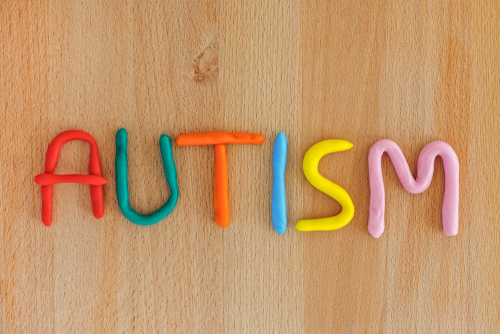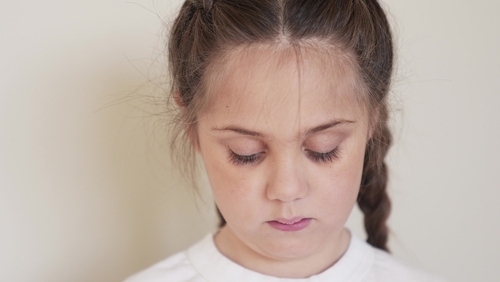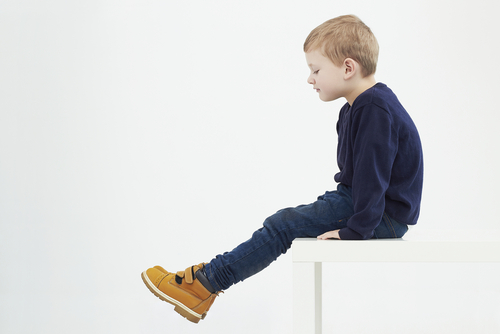
Autism Spectrum Disorder is one of the most commonly diagnosed developmental disorders. According to The Centers for Disease Control and Prevention (CDC), “Autism is four to five times more common among boys than girls and 1 in 59 American children are on the autism spectrum.” Understanding five red flags of Autism Spectrum Disorder (ASD) can help you identify potential problems early in a child’s life, giving them a better chance at healthy development. Identification of these early signs can lead to early intervention. Children who display symptoms of autism spectrum disorders or other developmental disabilities and have appropriate supports are in a better position to overcome common difficulties and integrate into society more successfully. That is why it is so important to know how to spot the early indicators, and these red flags for autism will help you do that.
Resource: 101 Resources for Homeschooling Kids with Autism
1. The Child Doesn’t Respond to Their Name

In general, babies learn to recognize their name and will acknowledge it by turning their head or with some other obvious gesture. In children diagnosed with autism, four out of five did not fit this behavior. This means that some children with autism will still respond to their name, and some without will not respond, but this is one of the earliest strong warning signs of autism spectrum disorders. Research suggests that this particular behavior is linked to language challenges, including delayed language skills, that often accompany autism.
Featured Programs
See Also: What are the 10 Most Common Signs of Autism Spectrum Disorder (ASD)?
2. They Don’t Imitate Behavior

Imitation is another part of early social behavior. Infants usually imitate others. From matching a smile to clapping, very basic forms of emotional expression usually start as plain imitations. These imitations can be of parents, siblings or nearby infants; the source doesn’t matter too much. A child who is struggling to develop socially will struggle even at the earliest stages, and this is where you will see stronger signs of that struggle. Without imitation, they may have difficulty expressing anything at all, even basic happiness or unhappiness, which ties directly to red flag number three.
3. They Display Less Emotion than Their Peers

As you can see, a child with autism spectrum disorder will have many difficulties expressing even basic emotions. This doesn’t indicate that they are without emotion, only that their ability to communicate is encumbered. The tricky thing is that this won’t necessarily translate to less crying as a baby. Instead, the easiest way to detect this sign is through empathy. Typically, infants will respond to other infants in kind. This is why one crying kid can set off a chain reaction throughout a nursery, but crying isn’t the only contagious emotion. Smiling, laughing and any other display can also be empathized or mimicked. A child with autism spectrum disorder will be much less responsive to these “contagious” displays of emotion.
4. They Don’t Engage in Joint Attention
Joint attention is a term that refers to “hey, look!” moments. A child goes through intense discovery many times a day, and that discovery is often exciting. Typically, in that excitement, they will want to share their findings. This leads to all of those moments where they clamber for your attention while pointing at the source of fascination. Circling back to communication struggles, autism inhibits this expression of discovery, making a child far less likely to engage in this behavior.
5. They Pretend Less

Starting at about the age of two, pretend play becomes a major part of a child’s day. While early stages of pretend can start sooner, this is usually when imagination starts to expand. In pretend play, an ordinary object can be anything. In cases of autism, children will still play with toys or objects, but there is little or no pretending and imagination plays a much smaller roll. Toys and objects will be used for their basic intended purposes, rather than becoming representative of a greater imaginative idea. This often leads to more repetitive actions, which is one of the easier ways to identify this autism flag.
6. Repetitive Behaviors

While repetitive behaviors are developmentally normal, they are more intense in an individual with autism. Infants and toddlers typically engage in repetitive behaviors like hand-flapping or rocking back and forth but eventually outgrow them. These unusual behaviors persist in an individual with autism.
Individuals on the autism spectrum can display two different groups of repetitive behaviors. Higher order repetitive behaviors include routine and rituals and intense or unusual sensory interests. Lower order repetitive behaviors include hand-flapping, fidgeting, and repeating certain phrases.
Featured Programs
7. Lack of Eye Contact

There are many reasons why a child may avoid eye contact and autism is only one of them. According to the DSM-5, autism can be characterized by persistent “Deficits in nonverbal communicative behaviors used for social interaction, ranging, for example, from poorly integrated verbal and nonverbal communication; to abnormalities in eye contact and body language or deficits in understanding and use of gestures; to a total lack of facial expressions and nonverbal communication.”
There is research to indicate that individuals on the autism spectrum may avoid eye contact for a number of reasons including:
- lack of social motivation
- inability to split focus between spoken language and another individual’s eyes
- find eye contact overwhelming or intimidating
8. Unusual Reactions
Some individuals on the autism spectrum have unusual reactions to stimuli in their environment. They may be exceptionally sensitive to:
- smells
- light wavelengths
- tastes
- textures
In an attempt to escape the discomfort, they may scream, throw tantrums, or run away from the situation.
Some individuals on the spectrum have an unusually high or low pain tolerance. This could cause an unusual response to something relatively minor like a paper cut. Other children don’t appear phased by something as serious as a broken arm.
Related Resource: Top 20 Best Applied Behavior Analysis Programs
Conclusion
Keep in mind that these autism red flags are fairly unreliable in the first year of a child’s development. Children develop at a different pace, so take the timelines as guidelines rather than absolute.
Still, as a child grows, these early autism flags can enable you to get an early diagnosis, which is the best thing that can happen for children with these challenges. If you have concerns, it is best to speak to your child’s doctor. If a diagnosis of autism is made, there are plenty of resources available to help. Autism Speaks is one such resource that’s available for families with a child on the spectrum.
